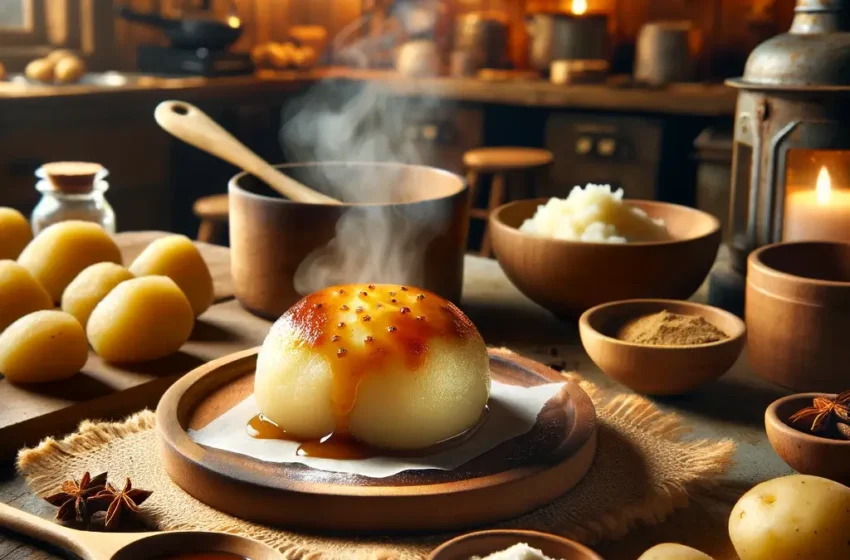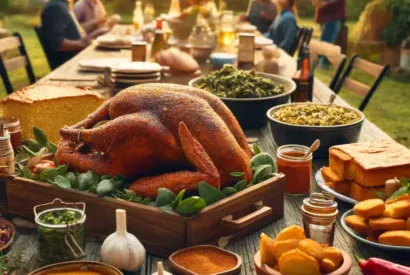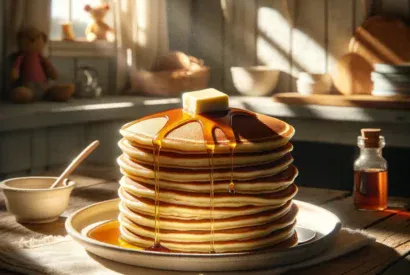Easy Homemade Potato Mochi Recipe: A Delightful Twist on Traditional Japanese Mochi
As a food enthusiast who’s had the pleasure of indulging in a variety of dishes from around the world, I was particularly excited to try out the “Potato Mochi.” This delightful twist on the traditional Japanese mochi combines the comforting texture of potatoes with the chewy, sweet essence of mochi. It’s a fusion dish that embodies simplicity and comfort, making it a must-try for anyone looking to explore Japanese-inspired cuisine at home. Here’s a detailed guide on how to make this delicious treat, along with pro tips, reasons to love this recipe, serving suggestions, and my concluding thoughts.
What is Potato Mochi?
Potato Mochi is a savory adaptation of the classic mochi, a Japanese rice cake made of glutinous rice pounded into paste and molded into shape. This version uses mashed potatoes as a base, combined with mochiko (glutinous rice flour), creating a unique texture that’s both chewy and soft. It’s then lightly fried to achieve a crisp exterior, offering a satisfying contrast with every bite.
How To Make Potato Mochi Recipe
- Preparation Time
30 minutes - Cooking Time
6 minutes - Serves
4 people - Difficulty
Easy
Ingredients
- 2 large potatoes (about 500g)
- 1 cup mochiko (glutinous rice flour)
- 1/4 cup water (adjust as needed)
- 2 tablespoons sugar (adjust to taste)
- Pinch of salt
- Oil for frying
- Optional: soy sauce, butter, or sweet soy glaze for serving
Instructions
Step 1: Prepare the Potatoes
- Peel and chop the potatoes into equal-sized pieces.
- Boil the potatoes until tender, which typically takes about 15-20 minutes.
- Drain the potatoes and mash them until smooth. Let them cool slightly.
Step 2: Make the Mochi Dough
- In a large mixing bowl, combine the mashed potatoes, mochiko, sugar, and salt.
- Gradually add water and mix until a smooth dough forms. It should be pliable but not sticky.
Step 3: Shape the Mochi
- Divide the dough into small portions.
- Roll each portion into a ball and then flatten it slightly to form a disc.
Step 4: Cook the Mochi
- Heat a frying pan over medium heat and add a thin layer of oil.
- Fry the potato mochi discs until golden brown on both sides, approximately 2-3 minutes per side.
Pro Tips For Potato Mochi Recipe
- Ensure the mashed potatoes are as smooth as possible to achieve a silky texture in your mochi.
- Adjust the amount of water in the dough depending on the moisture content of your potatoes.
- For a sweeter version, serve with a drizzle of sweet soy glaze or dust with powdered sugar.
Why You Will Love Potato Mochi Recipe
The Potato Mochi recipe is a delightful blend of simplicity and comfort, offering a new twist on traditional mochi. Its chewy texture paired with a crispy exterior makes it a versatile dish that can be enjoyed as a snack, appetizer, or side. It’s also gluten-free, making it accessible to those with dietary restrictions.
How to Eat Potato Mochi
Enjoy your potato mochi warm, with a dab of butter, a drizzle of soy sauce, or a sweet soy glaze for a delightful contrast of flavors. It’s perfect as a stand-alone snack or as a complement to a variety of dishes.
Conclusions
The Potato Mochi recipe is an excellent way to enjoy the fusion of Japanese and Western cuisine. Its simplicity, combined with the comforting textures and flavors, makes it a must-try for anyone looking to explore new culinary horizons. If you love this recipe, be sure to share it with friends and family!
You Can Also Read:- Seafood Ramen Recipe
FAQs on Potato Mochi Recipe
1. What is potato mochi?
A: Potato mochi is a savory snack that blends the traditional Japanese mochi, made from glutinous rice flour, with mashed potatoes to create a chewy and soft treat, often fried for a crisp finish.
2. Is potato mochi gluten-free?
A: Yes, since it’s made with glutinous rice flour and potatoes, both of which are gluten-free, potato mochi is suitable for those avoiding gluten.
3. Can I make potato mochi vegan?
A: Absolutely! The basic recipe for potato mochi is naturally vegan, just ensure any toppings or sauces you use are also vegan.
4. How do I store leftover potato mochi?
A: Store them in an airtight container in the refrigerator for up to 2 days. Reheat in a pan for best texture.
5. Can I freeze potato mochi?
A: Yes, potato mochi freezes well. Place them on a baking sheet to freeze individually, then transfer to a freezer bag. Reheat from frozen in a pan or oven.
6. What potatoes are best for making potato mochi?
A: Starchy potatoes like Russets are ideal as they mash well and create a smooth texture.
7. Can I use sweet potatoes instead?
A: Yes, sweet potatoes can be used for a sweeter version of mochi with a different nutrient profile.
8. What is mochiko?
A: Mochiko is a fine, glutinous rice flour used in Japanese cooking to make mochi and other sweets.
9. Can I add flavors to the potato mochi dough?
A: Definitely! Feel free to incorporate spices, herbs, or sweeteners into the dough to suit your taste.
10. What sauces complement potato mochi?
A: Soy sauce, sweet soy glaze, or a butter sauce can enhance the flavor of potato mochi.
11. Is this recipe suitable for children?
A: Yes, its mild flavor and chewy texture are often a hit with kids. Just ensure it’s cooled and served in manageable sizes.
12. How do I know when the mochi is cooked through?
A: The mochi should be golden brown on both sides and have a slightly crisp exterior.
13. Can I bake potato mochi instead of frying?
A: Yes, for a healthier option, you can bake them at 375°F (190°C) until golden, though the texture might slightly differ.
14. What’s the nutritional value of potato mochi?
A: Potato mochi is primarily a source of carbohydrates. The nutritional value can vary based on the ingredients and toppings used.
15. Can I use regular flour instead of mochiko?
A: Regular flour won’t give the same chewy texture as mochiko. It’s best to use glutinous rice flour for authentic results.
16. How can I achieve a crispy exterior without deep frying?
A: Pan-frying with a little oil over medium heat will give a crispy exterior without the need for deep frying.
17. Can potato mochi be eaten cold?
A: It’s best enjoyed warm to appreciate its chewy texture and crispy exterior.
18. How much water do I need to add to the dough?
A: Start with 1/4 cup and adjust as needed. The dough should be pliable but not sticky.
19. Can I make potato mochi with leftover mashed potatoes?
A: Yes, it’s a great way to use up leftover mashed potatoes. Just ensure they’re not too runny.
20. How thick should I shape the mochi?
A: About 1/2 inch thick is ideal for a good balance between chewy interior and crisp exterior.
21. Can I add cheese to potato mochi?
A: Yes, adding cheese can create a delicious melty center. Consider mozzarella for a stretchy texture.
22. How do I prevent the dough from sticking to my hands?
A: Wetting your hands with water can prevent sticking while shaping the mochi.
23. Can I use a food processor to mash the potatoes?
A: Yes, a food processor can ensure the potatoes are smoothly mashed, just be careful not to over-process.
24. How long does it take to boil the potatoes?
A: Depending on the size, it usually takes 15-20 minutes to boil the potatoes until tender.
25. Can I make potato mochi with other types of flour?
A: Glutinous rice flour is unique for its sticky, chewy texture. Other flours may not provide the same results.
26. How can I make a sweet version of potato mochi?
A: Incorporate sweet fillings like red bean paste or dust with powdered sugar after cooking for a sweet treat.
27. Can potato mochi be made in advance?
A: Yes, you can prepare the dough in advance and refrigerate it, or freeze the shaped mochi before frying.
28. What other dishes can I pair with potato mochi?
A: It pairs well with Japanese dishes like miso soup, teriyaki chicken, or as a standalone snack.
29. Can I use oil spray for a lighter version?
A: Yes, using an oil spray can reduce the amount of oil needed for frying, making it a lighter option.
30. What makes potato mochi different from traditional mochi?
A: Traditional mochi is made entirely from glutinous rice, while potato mochi incorporates mashed potatoes for a unique texture and flavor.












